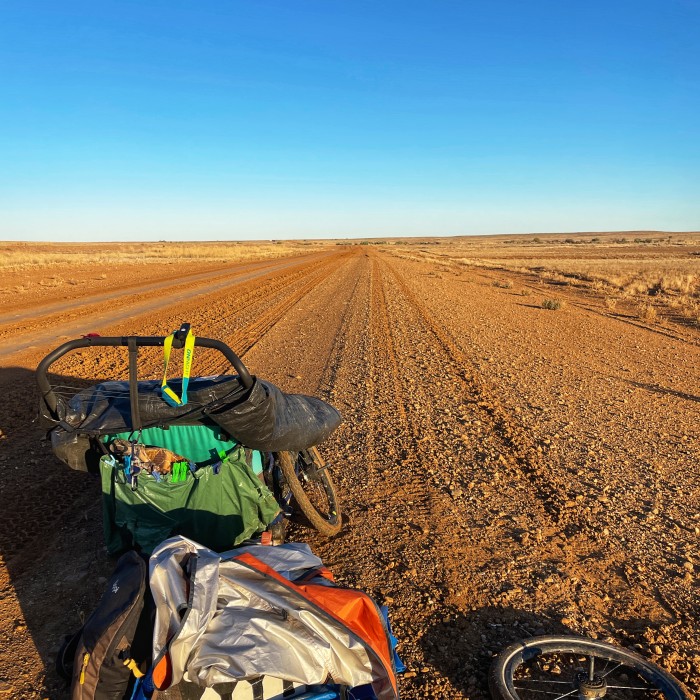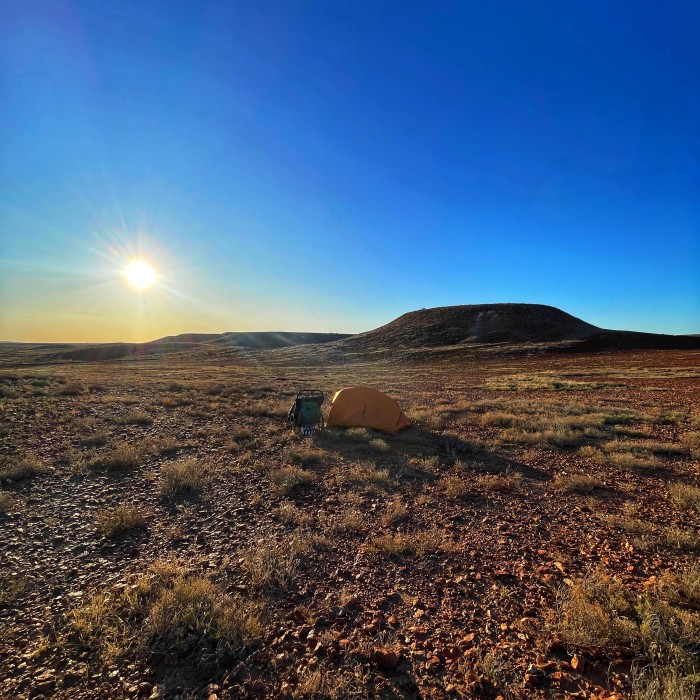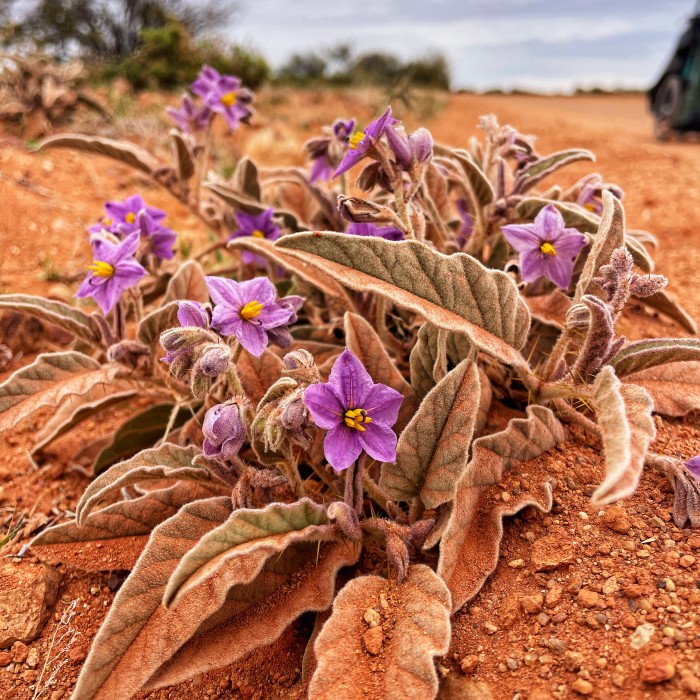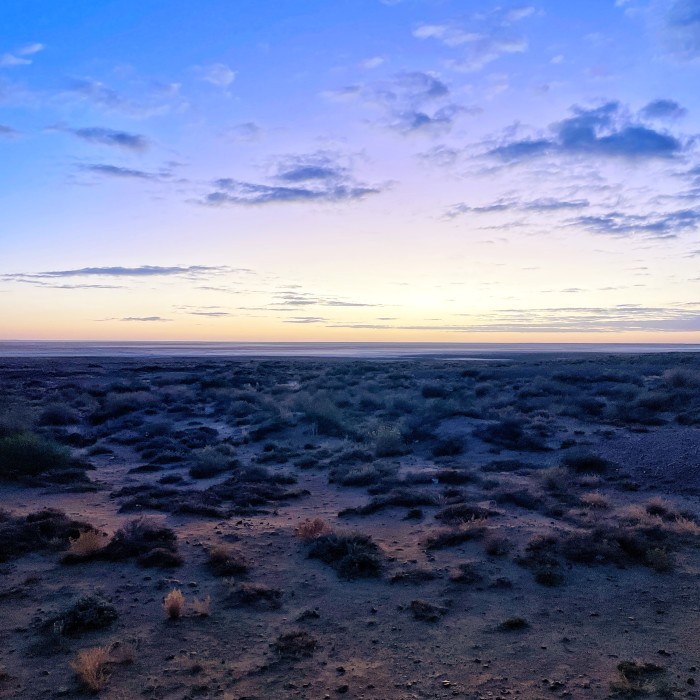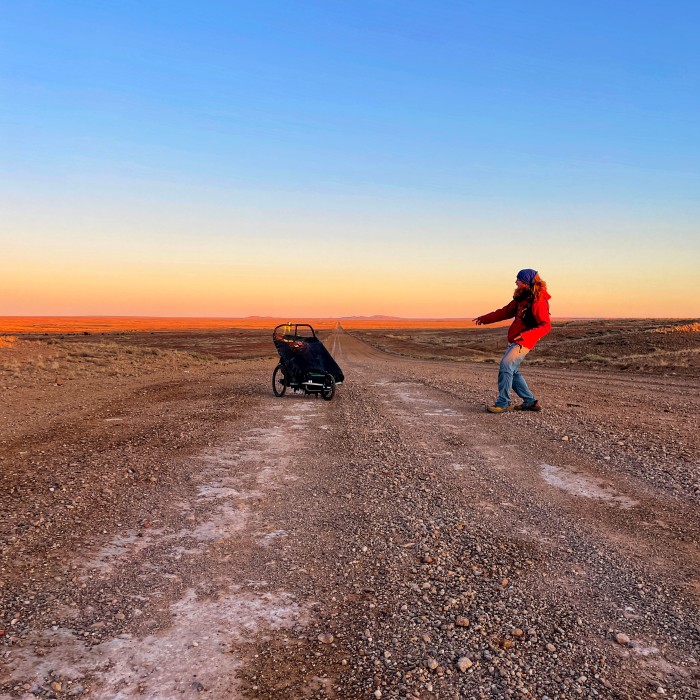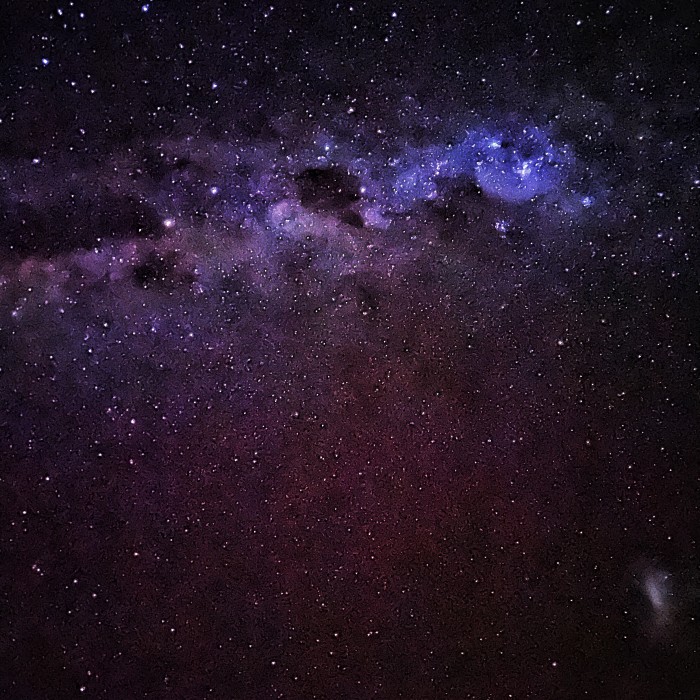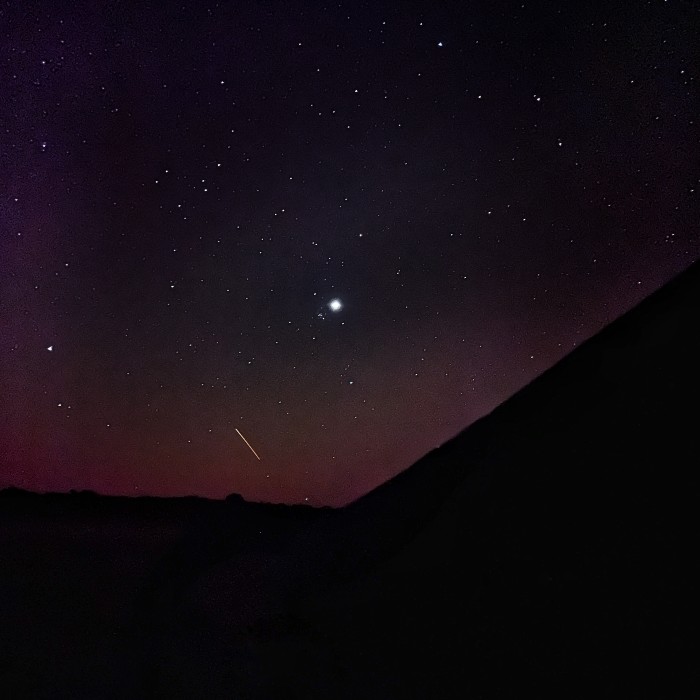
Pieroad - Outback Desert
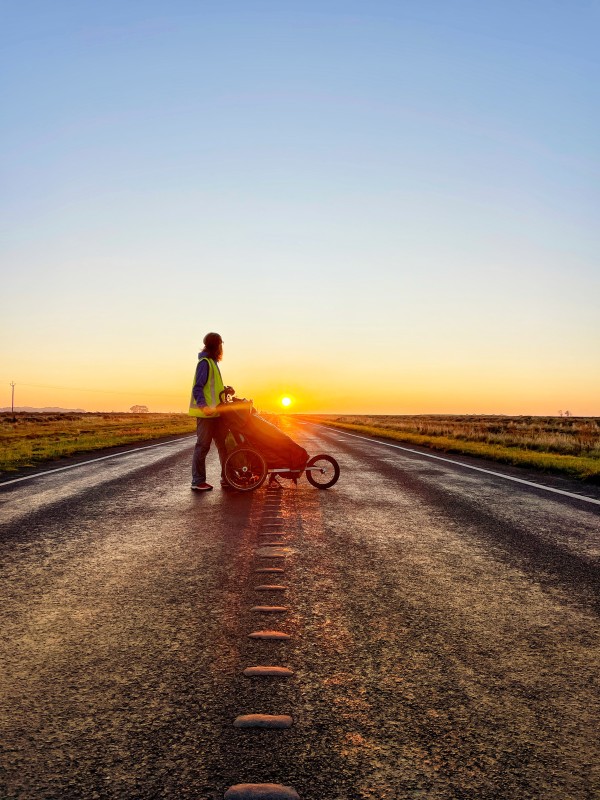
THE SONGLINES
At the beginning of time, Australia was a flat, lifeless land. Immense entities descended from the sky, came from the sea and emerged from the bowels of the earth. With their arrival, Creation began and life began to pulsate. As they moved across Australia, the entities shaped the earth with their bodies, creating rivers and mountain ranges and forests full of life. In everything they touched they left part of them behind, making every corner of the world sacred to those who knew how to look. In the east, Biame came to Sydney Bay, shaped its coastline, and after completing his work headed for the mountains, from where he returned to the sky. His path drew the bed of the great Parramatta River, and parting from earth raised the range of the Blue Mountains from the ground. Time began to flow and with it the river water from the mountains to the bay.
The first humans began to inhabit the land: the Aborigines. Their ancestral wanderings scattered them over the land like breadcrumbs on an immense table. They remained true to the nomadic nature of their Ancestors, became hunters and gatherers, and in a life devoid of eagerness chose to celebrate their dwelling by sanctifying the places they learned to recognize. For forty thousand years they knew and remembered every corner of Australia, without maps or roads, and by singing their stories they gave voice to the Songlines. In the gazes, between the lips, in the collective memory of hundreds of peoples, these timeless songs guided the steps of Aborigines on the first pilgrimage in human history: the Walkabout.
Walkabout was the way Aborigines moved through the inhospitable lands of Australia. Since they lacked writing, they relied solely on oral traditions, learning where to go and how to move through their songs. They indicated where to find food, at what time, how to orient themselves in the wilderness and when to move according to the season. The Songlines marked the location of each tree, rock and horizon, vestiges of the footprints with which Ancestors had shaped the land. The whole of Australia, an area the size of Europe, was "mapped" with countless songs over tens of thousands of years, creating a dizzying connection between the land and its inhabitants. The arrival of English settlers in the late 1700s wiped out this culture within just two centuries. By now, along with the Aborigines, the invisible traces of the Songlines are also disappearing. The ancient tales have shriveled into scattered, disjointed words, but what remains still has the power to fascinate, and a few traces have fortunately managed to survive.
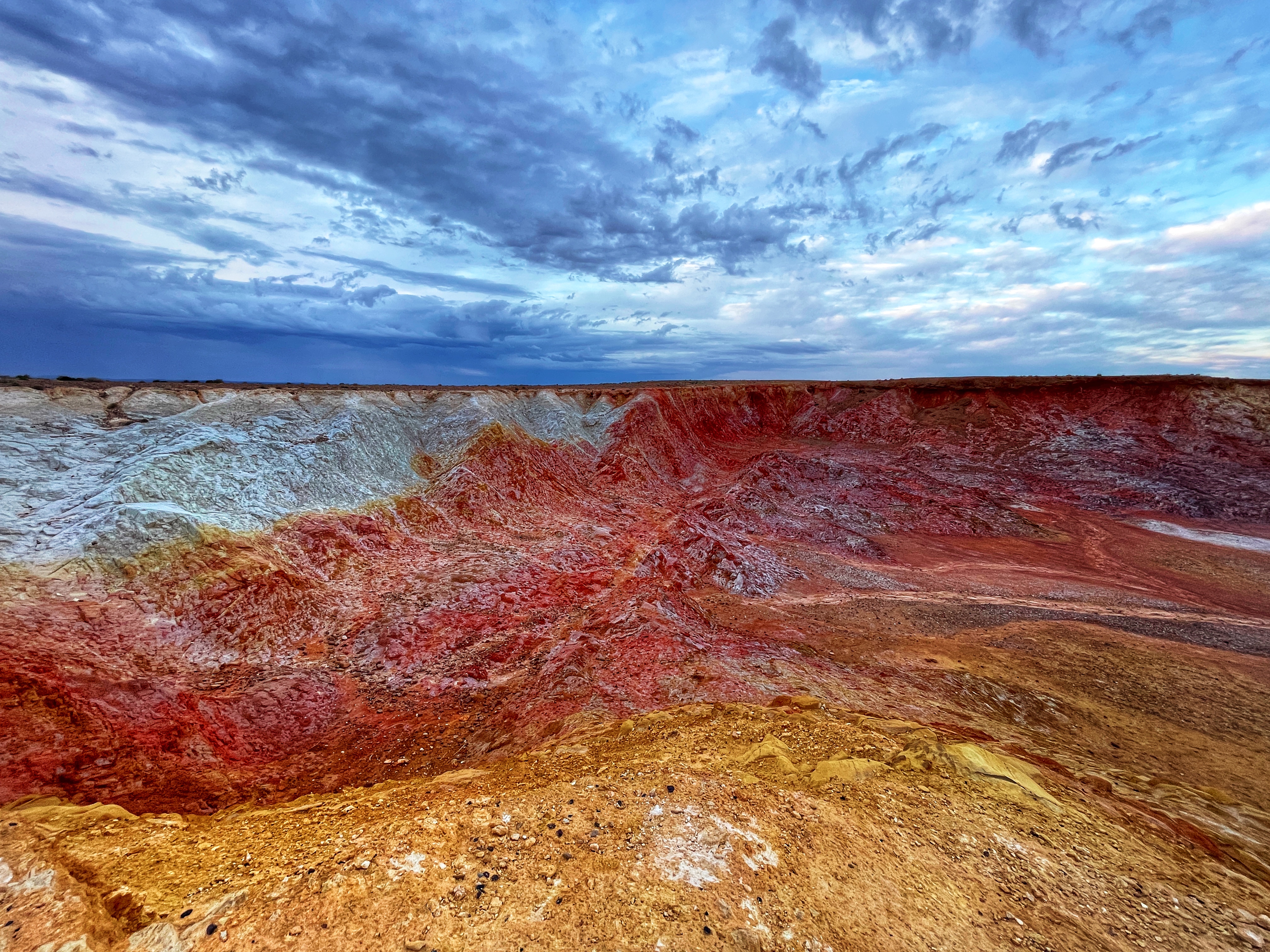
THE OCHRE ROAD
The Arabana were a tribal group established north of the present metropolis of Adelaide, capital of South Australia. They lived in a territory rich in ochre, a material used as a pigment in cave paintings, in medicine and for ceremonial purposes. Ochre was bartered with peoples near and far, and over time a Songline was voiced that crossed the country from south to north. The trade route meandered through the Outback, the giant desert sitting in the center of Australia, evading temperatures approaching 50 degrees in summer and providing a reliable route for three thousand kilometers to the extreme northern foothills.
The Road was sung for forty thousand years and in 1860 was translated by interpreters to John McDouall Stuart, a Scottish adventurer. Relying on the knowledge gained from the natives, Stuart embarked on a series of exploits that culminated in the crossing of the country, becoming the first Western explorer to penetrate the heart of the desert and reach the shores of the Indian Ocean. For modern Australia, it was a momentous turning point. Based on information gathered by Stuart, the railway and telegraph lines were built. Adelaide and Melbourne finally had a direct connection to Darwin and its port facing Asia.
Before then it was necessary to circumnavigate the whole of Australia. It is difficult to make a comparison with Europe, but if we were only taking distances into consideration, it would mean that between Lecce and Oslo there were no roads but only a boundless wasteland with no obvious landmarks, and the only way to get from one to the other was to go around the continent by sailing through the Mediterranean, the Strait of Gibraltar, and finally up the west coast to our destination. The Australian distances are impressive, and to grasp them requires a considerable stretch of the imagination. Alternatively, one can rediscover the ruts left by Stuart and the Song of Ochre Road by joining scattered dots on the map and setting up meticulous logistics to deal with the indifference of the desert. Only by walking can one realize the immensities that nomadic peoples have embraced; it is therefore by walking, between May and September 2023, that I tried to experience them.
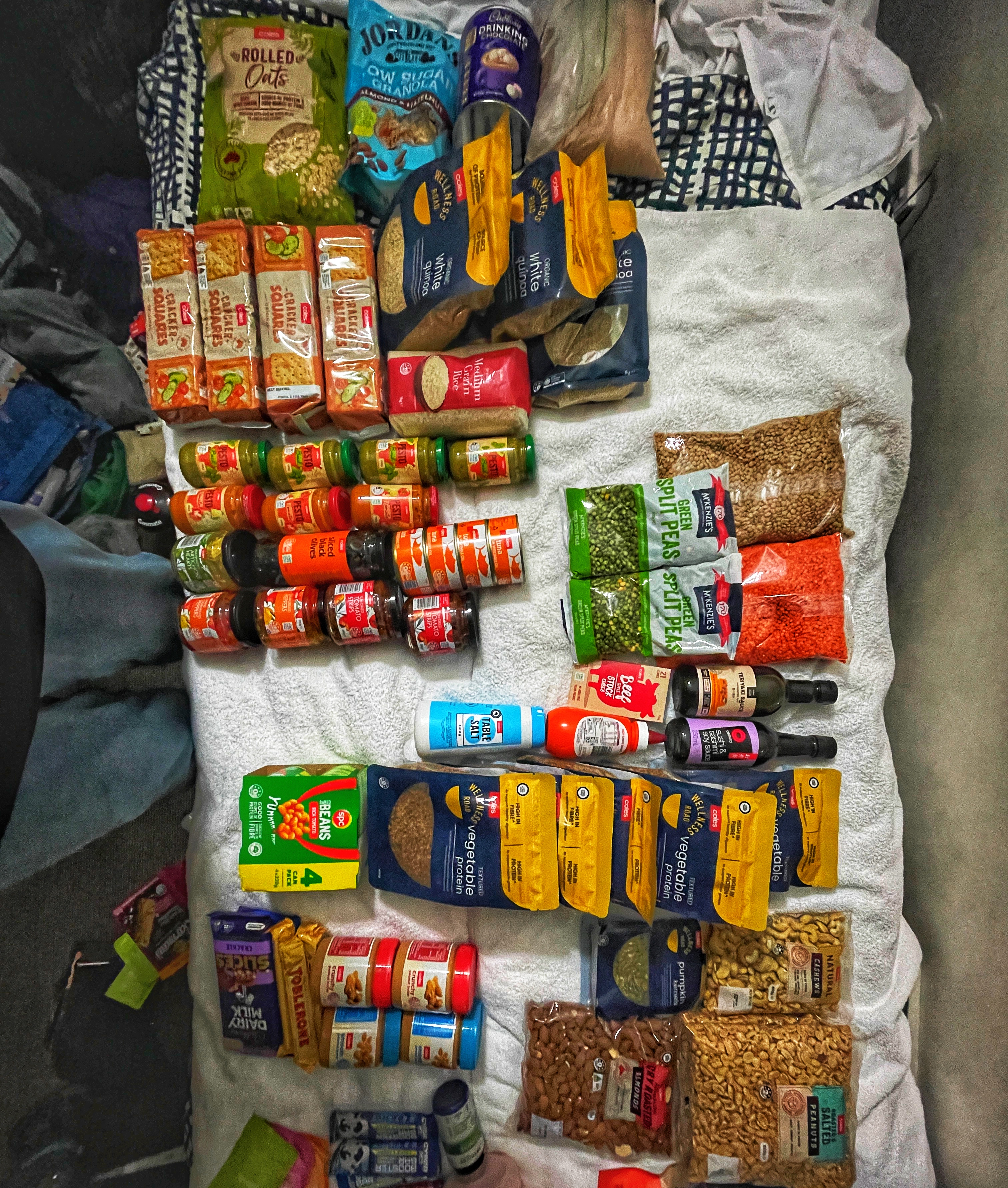
BREAKING IN
I arrived in Adelaide after a substantial period of breaking in. I had left Sydney, on foot, a month earlier, so as to gradually get into the Australian orders of magnitude before tackling the desert. Sydney lies to the east of the Blue Mountains, past which, for hundreds of kilometers, fields of wheat, barley, lupins and lentils compete to move the horizon farther and farther away. Towns had slowly faded into isolated villages, then into population centers with a few dozen people.
The first few weeks were reminiscent of walking in the Argentine Pampas. Wide expanses of squared-off land and endless pastures, few four-legged animals, fewer men, lots of sky. The Latin American estancias were now called stations, a different name that told the same story of stubborn settlers devoted to raising sheep and cows. A single road stretched to the end of the view before disappearing into perspective. This time, however, there was no towering outline of the Andes to dictate boundaries. The white trunks of the eucalyptus trees had replaced them, and from their rustling foliage the birds were sending out their calls. I learned to recognize the laughter of the Kookaburra and the ethereal cry of the Butcherbirds, the trill of the green parrots and the candid flash of the cockatoos. The monotony of the landscape enhanced their sounds and movements, and it came to mind that perhaps the Songlines had been inspired by them to give voice to the known world.
In the 1,400 kilometers traveled between Sydney and Adelaide, I noticed one recurring element: every village was provided with a minimal post office. Sometimes the same service station, an unfailing lifesaver for vehicles venturing on these endless roads, performed the function of receiving and sending mail. This was an important detail, because in the next part of the journey I could send food to the points through which I would pass. Even with Ezio, the stroller that carries everything I need, it would not have been possible to stow enough supplies to cross the entire desert.
FINAL PREPARATIONS - WITH BATED BREATH
Adelaide was the last major city I would pass through. After that, Darwin. Three thousand kilometers separating them and a single major town in between, Alice Springs, the desert capital, barely twenty thousand inhabitants but, crucially, a supermarket to stock up at. Adelaide to Alice Springs would take me two and a half months, walking at the rate of 40 to 45 kilometers a day - ten hours including breaks. I roughly calculated a rest day every ten. Visa times left little margin, and to take advantage of winter and avoid the fifty degrees of other seasons, I would keep up a rapid pace.
I decided at the table what I would eat for the next few months, at every lunch and dinner. Practicality and energy intake mattered; flavor took a back seat. For lunches I bought six pounds of rice and quinoa, for dinners two of lentils and two of vegetable protein. I hoarded oats, powdered milk and cocoa for breakfast, and for snacks dried fruit, honey, peanut butter and chocolate. Bags of cryo-dried fruits and vegetables would at least partially make up for the lack of fresh vegetables.
It was unwise to rely on what I might find along the way, so I left with the idea that I would buy little or nothing for the next few months. Ezio was over fifty pounds when we took our first steps toward the outskirts of Adelaide. In addition to food, he was carrying about ten liters of water, which in winter temperatures was equivalent to five or six days' autonomy; a small pharmacy, complete with bandages and snake venom remedies; spare parts; a solar panel to recharge electronic devices; gas and gasoline stove with associated tanks. May was winding down when we set out to follow Stuart's trail to the desert and into ourselves.
The road turned away from the coast pointing northeast and towards the Flinders Ranges, a low mountain range stretching 400 km northward. Stuart used it as an initial landmark as he headed toward the vast unknown distances of the further regions. The presence of the elevations mitigated the climate, protecting the area from the surges of inland areas. The eucalyptus trees were still lush and the tent was damp in the morning. I encountered almost one human settlement a day, yet as I continued, signs of human presence became sparse. For long hours, the only tangible sign of human presence was the road I was treading. I managed to keep my supplies stable but the wait for the desert became nerve-wracking. I was eagerly waiting to confront it.
I remembered the walk in the Atacama Desert in Chile a year earlier. One lesson I had learned was that connecting to its dissolution takes days, sometimes weeks. The longer you stay in the desert, the deeper you can dig. Getting to know yourself is a dizzying sensation, and at times, in an unexpected reversal of perspective, nostalgia removed its cloak from home to envelop the time spent inside the Atacama. Its still spaces suggested ideas of infinity, death, god, beauty, stillness. Nothing else could dwell among those gray stones. Like eternal guardians, they held up the mirror in which to observe one's own frailties: those of man as an extra and of the human as mortal.
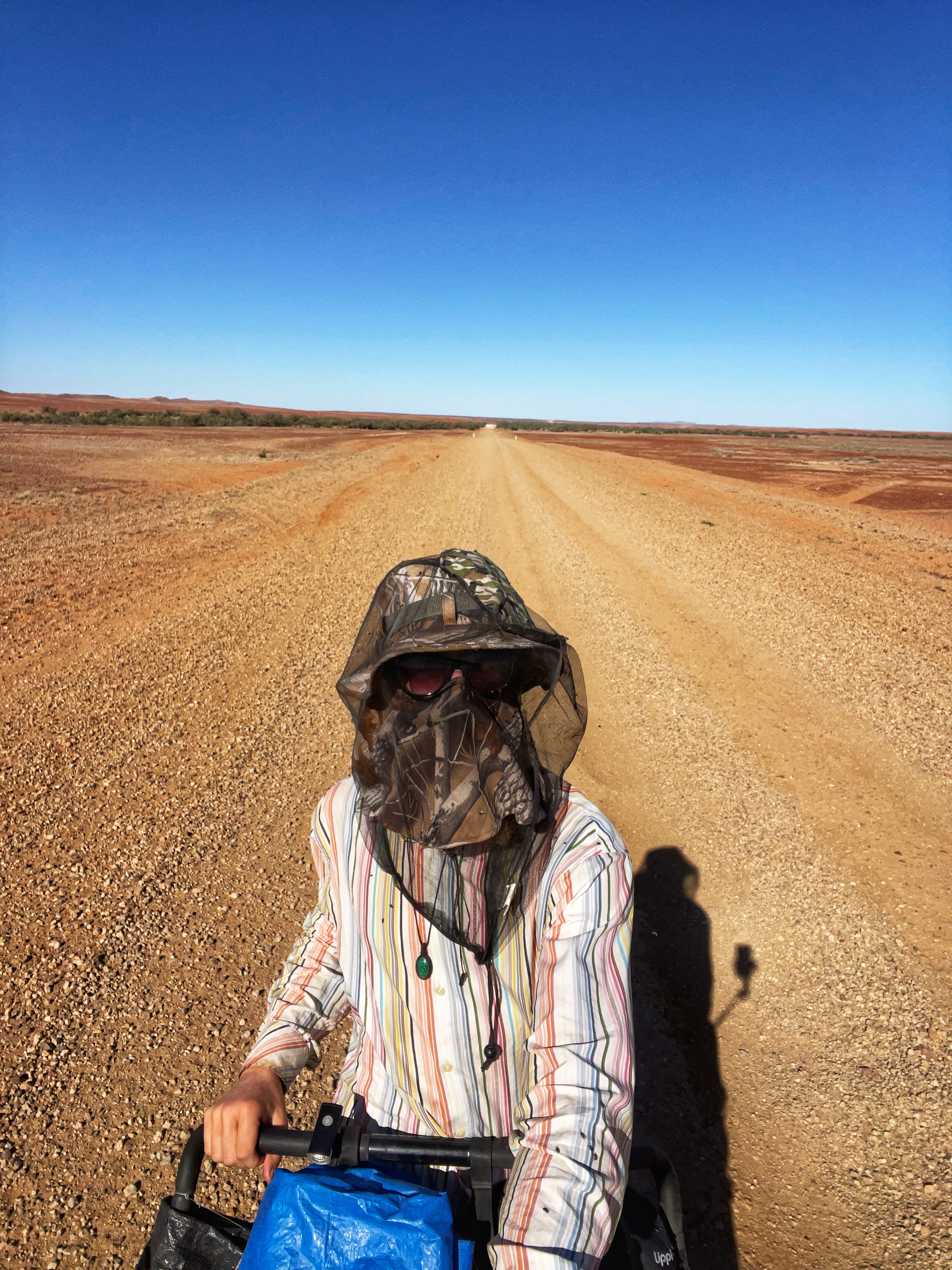
OODNADATTA TRACK
It took three weeks to reach the gates of the desert. The road stopped abruptly at the village of Marree, twenty souls in all, leaving a dirt track to guide me. The gas station was a cubbyhole nestled in the half-light offering food that had arrived weeks earlier with the arrival of the last truck. The prices were prohibitively high and the selection very poor. The bottom of the store was devoted to spare parts for cars, motorcycles, and bicycles: inner tubes, liquid sealants for punctures, a few screws, some cellophane-wrapped cloths. Near the cash register were touring items, among which faded postcards and stickers stood out. One of them read: WHERE THE HELL IS MARREE?
I smiled for a moment, then my gaze was caught by a green patch edged in yellow, the kind you use to sew on backpacks to have a switch to go off when you are trying to make conversation. The patch consisted of simple lettering, with numbers marked in small print immediately below. The inscription: OODNADATTA TRACK. The numbers: WILLIAM CREEK 204 - OODNADATTA 406 - MARLA 613. An empty feeling gripped my stomach. Those numbers were distances and indicated how far I would have to walk over the next few weeks to get from one point on the track to another, little more than names on a map. The mileage was calculated from where I was at the time, the town of Marree, the beginning of the Oodnadatta track.
Oodnadatta track is the track that has undergone the fewest changes from the route Stuart traveled one hundred and fifty years ago and in fact represents the most authentic, difficult, immersive, and alienating piece of the Explorer's Way, the road that retraces the explorer's steps through the Outback. A few years after Stuart's venture, telegraph and steam trains sprang up along the trail, spurring the development of a few modest stations to operate the rail line. It was Afghan migrants, among others, who built the rails; and it was Afghans who first introduced camels to Australia. The arid environment was congenial to them, and soon they were used extensively to transport goods along the desert tracks. The railway line was later christened The Ghan, to pay homage to the Afghan contribution to its construction.
The train operated for a century, until, in 1980, it was moved west, arm in arm with today's Stuart Highway, the paved snake that runs from Adelaide to Darwin by the straightest route. The shift of the line led to the death of the stations: deprived of jobs, people fled such hostile and isolated environments. Only two centers survived the sunset: William Creek and Oodnadatta, the names that the green patch intersperses with over two hundred kilometers.
From the information of those who had ventured there in off-road vehicles, I had an idea of the condition of the trail and doubted whether I could keep up the pace I had maintained up to then. In my head, two hundred kilometers became five days of walking, maybe six. In between, man-made nothingness. No infrastructure whatsoever except for some rusting railroad wreckage, no supplies. Three times, two hundred kilometers at a time, there would be only the trail, the desert and Ezio. The world would shrink to the present, and what I needed would shrink so much that it would fit exclusively inside a stroller. It was beginning to get serious.
The night before departure I played dice with some guys I met in the village, contemporary migrants from Italy, Chile and Argentina. Inside the container used as a kitchen, Spanish and red wine sat with us around the table of luck. We tried our luck as the night magnified the hours; when they were on the verge of shrinking, we went to sleep. The sleeping bag welcomed me generously, as always, but I slept little, as often happens on the eve of important departures.
To take advantage of all the daylight hours, the alarm clock was set for 5:30 a.m.; half an hour later I was on the road. Past the village, the asphalt line faded into the fine earth. A tall sign straddling it said alarmingly that the trail was closed, while in the east the aurora colored the early hours of the day pink and orange; there were no shadows between us and the sun.
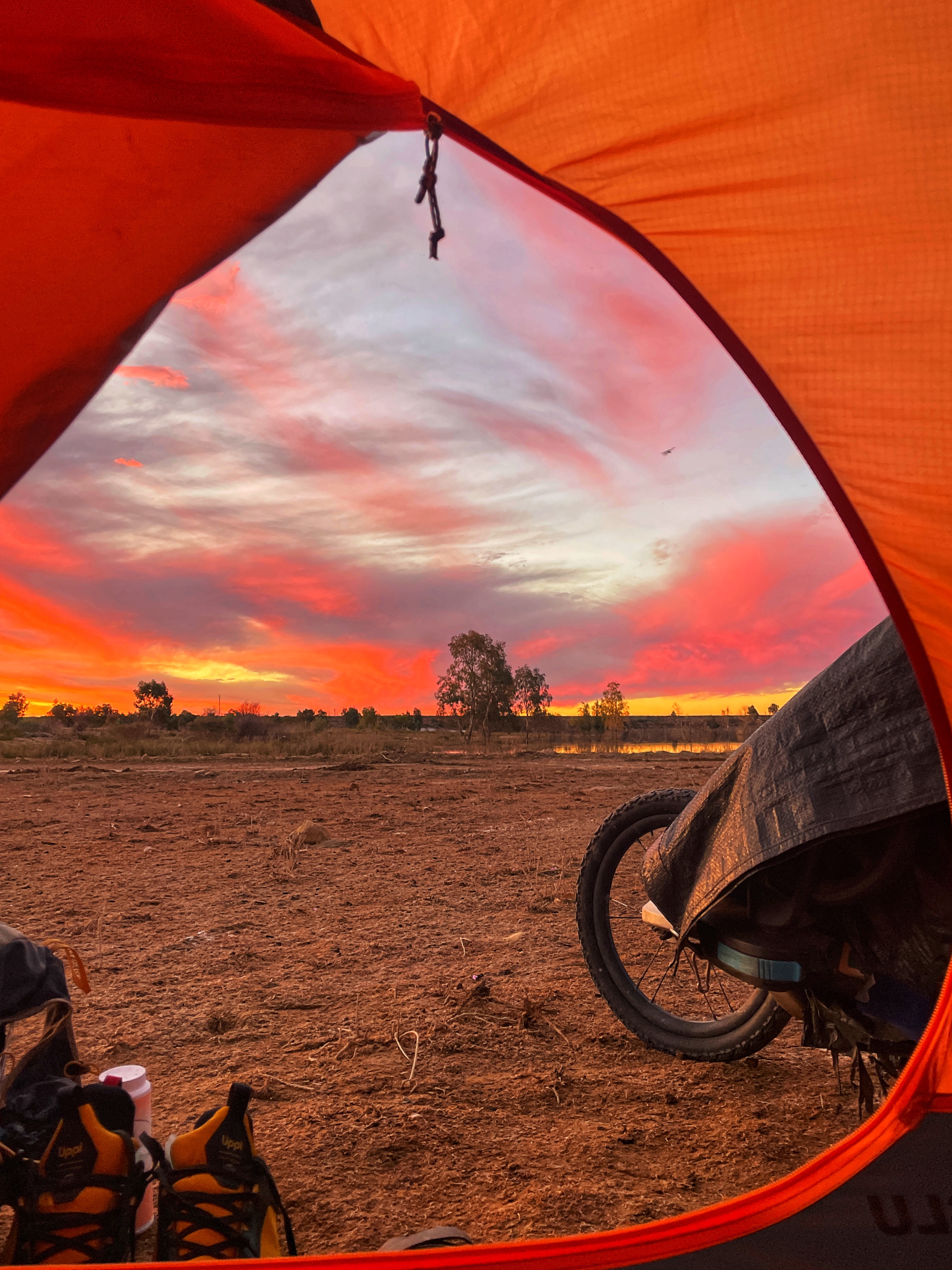
WITHIN THE SILENCE
I set off determinedly northward, beginning to observe and mentally note the road conditions. I was just thinking that the stories, as usual, had magnified the difficulties of the track, when Ezio suddenly slowed down on the right side, as if held back by an invisible force. I shifted my gaze to the side, sliding it down to the wheel: punctured! The sharp point of a spinifex protruded from the tire. The ground was a mixture of dry mud, shrubs, and salt crusts that concealed threats beneath its hard rind. After the replacement there remained two inner tubes for the rear wheels and two for the front; there were also patches and tire glue among the spare parts, so for the time being I could rest easy; but the fact that I had a puncture after only two kilometers was a discouraging sign.
The first day is about calibrating the estimates made at the table: what to do if they are wrong? Turning back requires humility, at least as much as moving forward requires courage and confidence. A puncture, in an environment like the desert, makes one raise the antennae and continue with extreme caution, muscles tense and eyes darting from side to side as if suddenly it had turned into a bed of broken glass. As the weeks passed, Ezio would become lighter from the weight of food, thus exerting less pressure on the wheels and therefore decreasing the likelihood of punctures. However, it would happen slowly, at the rate of a pound a day-the water could be considered constant because it had to be refilled at each station.
I thought all of this as I pumped air into the new inner tube and would repeat it every morning, like a litany, over the next few weeks, updating the supplies left, the weight Ezio was carrying, and every tiny change that gave something to counteract the pressure exerted by the desert against the mind and body.
The rest of the day went smoothly. Around four o'clock the gps read forty kilometers, a reasonable figure. I began looking for a place to camp, and a hill covered with stones seemed an ideal place to pitch the tent. The last effort of the day was the bumpy climb to its summit. I had not calculated for the rough terrain, and lifting the stones from in front of Ezio took longer than expected. When I reached the top, however, the view was sensational.
The landscape was utterly mundane, devoid of superb mountains or garish colors. Yet, having sweated the day and, most recently, the hill, had clothed those dark rocks with the aura of beauty. Fatigue had spread a veil before their eyes, and the world they observed seemed to have acquired a sense and stillness that could not exist elsewhere. Behind the hill to the south, a tongue of land with raised edges suggested the origin of that unusual pilgrimage. On the opposite side, the trail disappeared behind yet another hump, devoured by the ground. The place had no name, no number officially indicating where it was in relation to Marree. Even describing it in detail or showing a picture, that place would be untraceable to anyone attempting to get there; and even to those who had the exact geographical coordinates it would remain unknown, for when I arrived there, tested by the walk, I had the right frame of mind to stop and appreciate it. I liked to think that I was probably the first person to rejoice in that insignificant corner of the world.
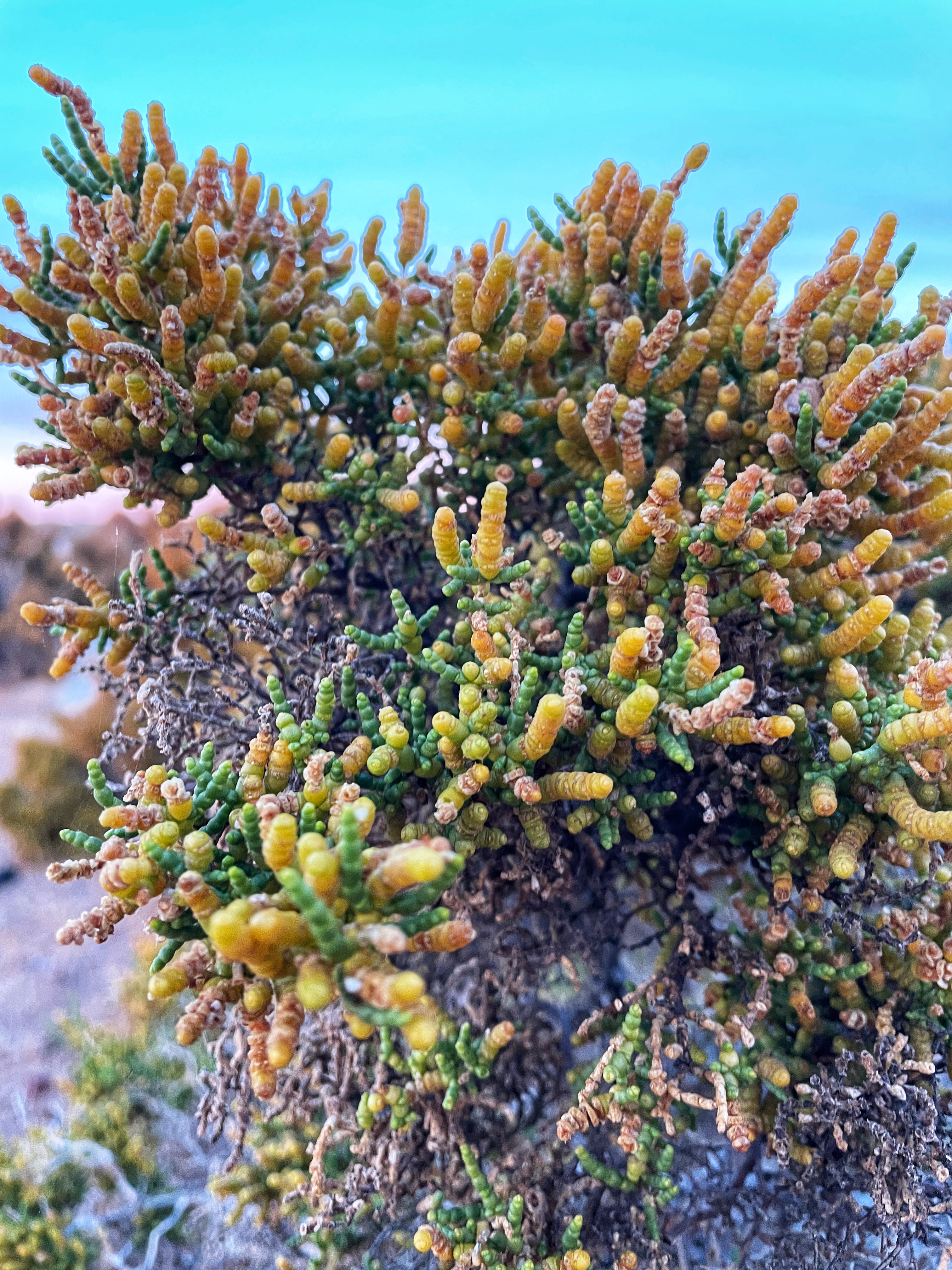
A NEW DESERT
The amount of flowers popping up on the edge of the track was impressive. I soon learned to recognize them, although I did not know the names by which they were classified. Yellow and purple were the dominant colors; then white and red. There was a flower with a pink and green rosette-shaped corolla, a yellow center, and touching it left the gently wrinkled feel of tissue paper on my fingertips. A shrub with fleshy green thorns sported a spherical yellow mimosa-like pon pon while at its feet daisies had gathered fire in the center of their petals and spread an exaggeratedly intense tea tree scent for their small size. I looked for them with my eyes, especially in the afternoon when I was most tired, and it seemed as if I were meeting up with friends I had just met. Making a date with them made little sense: they would suddenly appear, a few steps away, shaking their heads to go along with the wind.
The hours dilated and the days acquired an overwhelming density, blurring and separating according to the degree of concentration. Did it make sense to distinguish them? At times it seemed not, indeed keeping track of them made one feel tired; however, not doing so felt like going mad, lost in a formless time that spoke no language. Lake Eyre appeared for a few hours at dawn on the third day; or was it perhaps the twilight of the fourth? The night I camped opposite it, a long howl made the night shiver, followed by mournful echoes. It was the greeting of the dingoes, the wild and free dogs of the desert. Why is there a lake in the desert? And how do you explain the flowers?
The Outback is a region of contrasts. Although its surface is inhospitable, thousands of meters deep lies one of the largest artesian aquifers on earth, the Great Artesian Basin. It is a freshwater reservoir created millions of years ago from an inland sea in present-day Australia. The underground reservoirs hold billions of liters of water and are fed annually by the rainy season that bedevils tropical regions to the north. The water seeps for kilometers into the permeable soil and ends its course in the bed of the artesian basin. In some places there are rises that feed springs-this is how life endures in these deadly areas. It was thanks to the springs that the Aborigines were able to establish the Song of the Ochre Road, verbally noting the location of each one; and it was thanks to them that Stuart was able to cross the desert for the first time.
Lake Eyre today is a salt crust unfit for life, witness to an extinct sea. Water supplies are buried two thousand meters below the ground and it is rare to glimpse an active spring. However, I can call myself lucky. In past years the rainy season has been particularly abundant, and from the north, streams have come to wet the heart of Australia. For once, paradoxically, climate change has favored life.
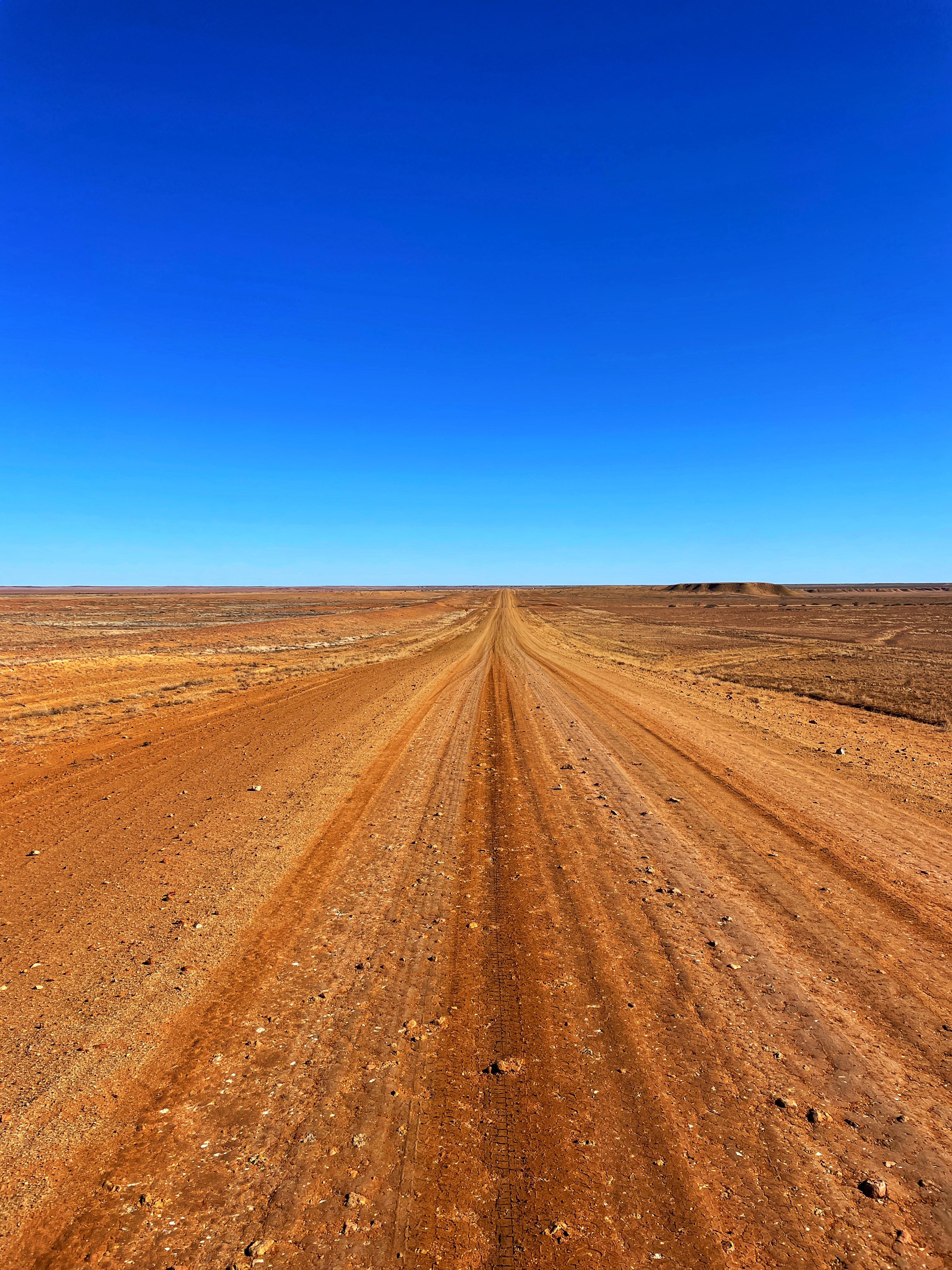
WITHOUT BREAKS
As the days went by, loneliness sharpened the feeling of alienation. Morale began to swing on a seesaw, and at times it seemed that the distance left was too great. Despondency sat on my chest and oppressed it, knowing that I had nothing to counteract it to distract me. I had been walking in the Outback for months and still had not covered half the distance. Reaching Darwin seemed too much, too far. Months. It was another three months until arrival. The surface of the trail had become uneven, making it slow and painful to move forward. There was also the wind, unexpected, which, ominously reminiscent of the angry gusts of Patagonia, was constantly pushing against the direction of travel. There was no day that it blew favorably.
I would arrive in the evening exhausted, with weighed-down muscles, and once I chose where to camp I had to raise my guard to check for poisonous spiders or snakes. Once, resting the waterproof sheet on the tent, a hairy spider the size of the palm of my hand appeared running neurotically. It was disgusting. I tried to move it with a dry branch, but that one slipped away undaunted and with extreme horror disappeared under the basin. It was impossible to flush him out. Disturbing images projected it crushed and bloody under my back, or waiting for the complicity of darkness to sneak past the only source of heat in the vicinity: my lying human body. The very thought made one shiver. Keeping your imagination at bay is especially difficult when you are tired, alone and in a hostile environment. But precisely because I was alone and in a potentially deadly environment, I could not let despondency bring me down.
After five days of walking, the trail returned to asphalt for a thousand blessed yards. I had arrived at William Creek, the first outpost on the Oodnadatta track. A pub, flanked by a gasoline pump and a hangar housing propeller planes, were the only buildings. Because of the isolation, places like this have a charter runway. Planes are used for refueling cargo, emergency rescues of people lost in the desert who manage to send a distress signal and, in some cases, for tourism. I drained two liters of fresh water and put under my teeth a hot and tasty meat pie, the meat-filled pastry typical of Australia. Charging the gps took a good two hours; then it was time to get back on the trail.
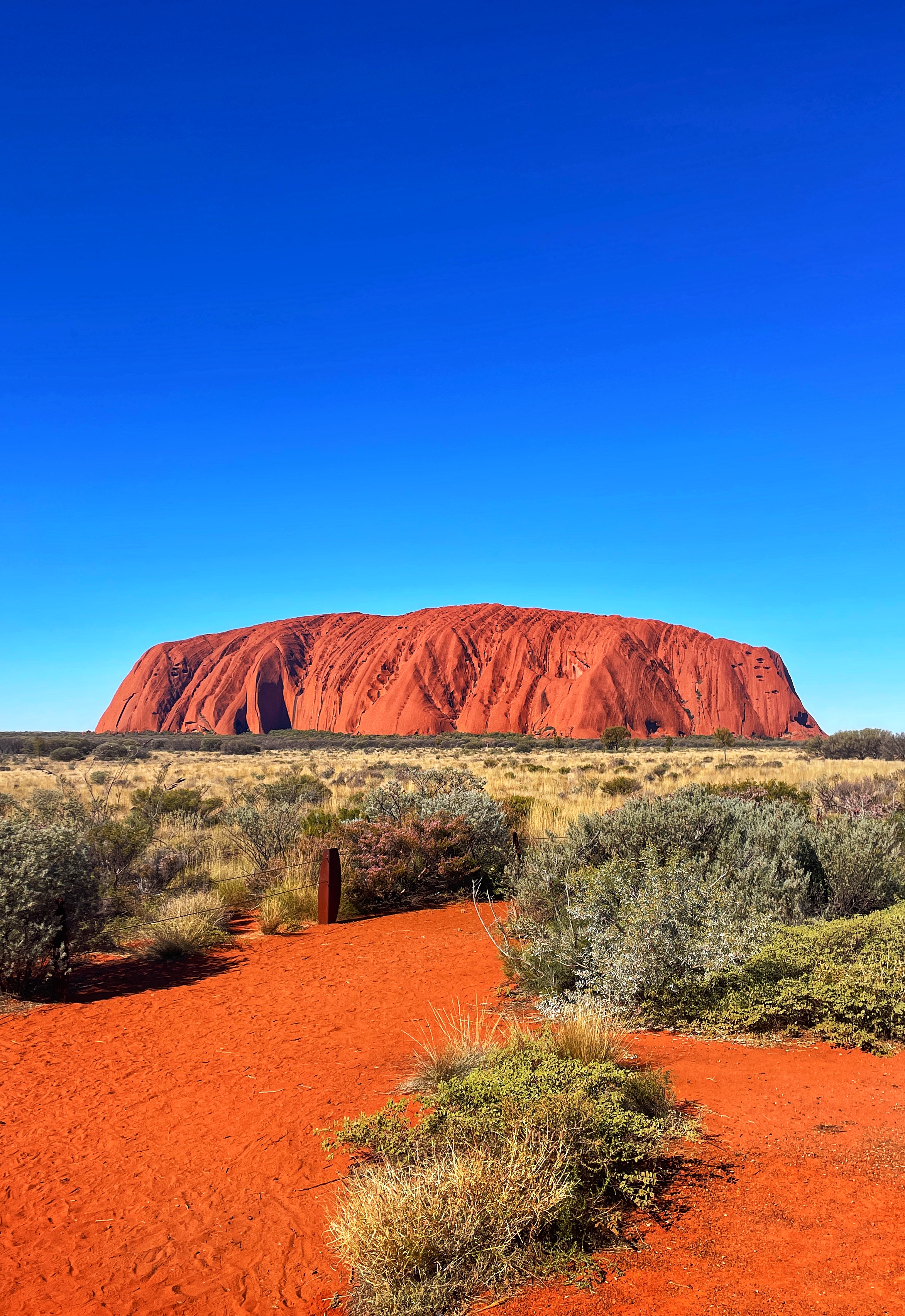
IT TAKES METHOD
I had covered barely a third of the track but the disconnect seemed to last for weeks. It took another ten days to complete it and return to a glimmer of humanity: a paved road, a few road signs, an occasional truck. Internet connection remained absent, leaving room for inner dialogue. I realized that I needed to stick to a method if I didn't want to freak out and lose focus. The challenge became to grind out miles according to a set plan: regular breaks, no variation, and focus on the immediate future, the milestones a week from now. I momentarily shelved the idea of getting to Darwin and finally entered the desert, embracing the route day by day. The mind wandered, daydreaming of stories and journeys in minute detail. But it also became natural to quiet my thoughts, let my legs go it alone, and gaze for hours at the clear blue sky, clearing my mind trying to imitate it.
They were moments of total peace that made you want to live forever in the open air and sleep in tents and eat while looking at the horizon from the roadside. Being under the vast sky filled me with joy. A powerful sense of freedom began to pulsate in the air because, at last, I had come to a balance. The desert had entered me. It had dug a hole and then suggested how to fill it: to ascend the abyss it was necessary to let go of things and people and reach down to the pieces of identity that were believed to be clinging so deep that it was impossible to give them up. Yet roots can be cut. From initial disorientation, one moves on to anguish at the lack of reference points, colors take on somber tones; but after getting lost, one finds oneself, and observes that even though everything has changed inside, things still play out the same way outside. Freeing yourself from the narratives that have formed your identity brings you closer to your essence. The freedom is such that, if you want it, perhaps it is even possible to go back. Time knows the only answer; and so far it has not wanted to tell me.
The remaining months continued slowly, keeping Ezio and me company. We walked thousands more miles and made a two-week detour to pay homage to Uluru, the monolith sacred to the Aborigines, the keeper of creation myths and legends. Once we reached Alice Springs, we rested a few days. The visa clock ticked inexorably. Northward we celebrated 20,000 kilometers and three years on the road, far from home. Nostalgia accompanied the steps, finally in silence, accepting its place in the choice to make the round-the-world journey on foot. Darwin was a long-awaited gift, without surprises, like the rewards one gets after an effort so intense that even desire has been taken away from them. We touched the Indian Ocean with hands, shoes, wheels and feet. We watched it flatten and make room for the sky, blending blues into a distant horizon. We had crossed the Australian desert. And after six months and six thousand kilometers, the journey in Australia came to an end.
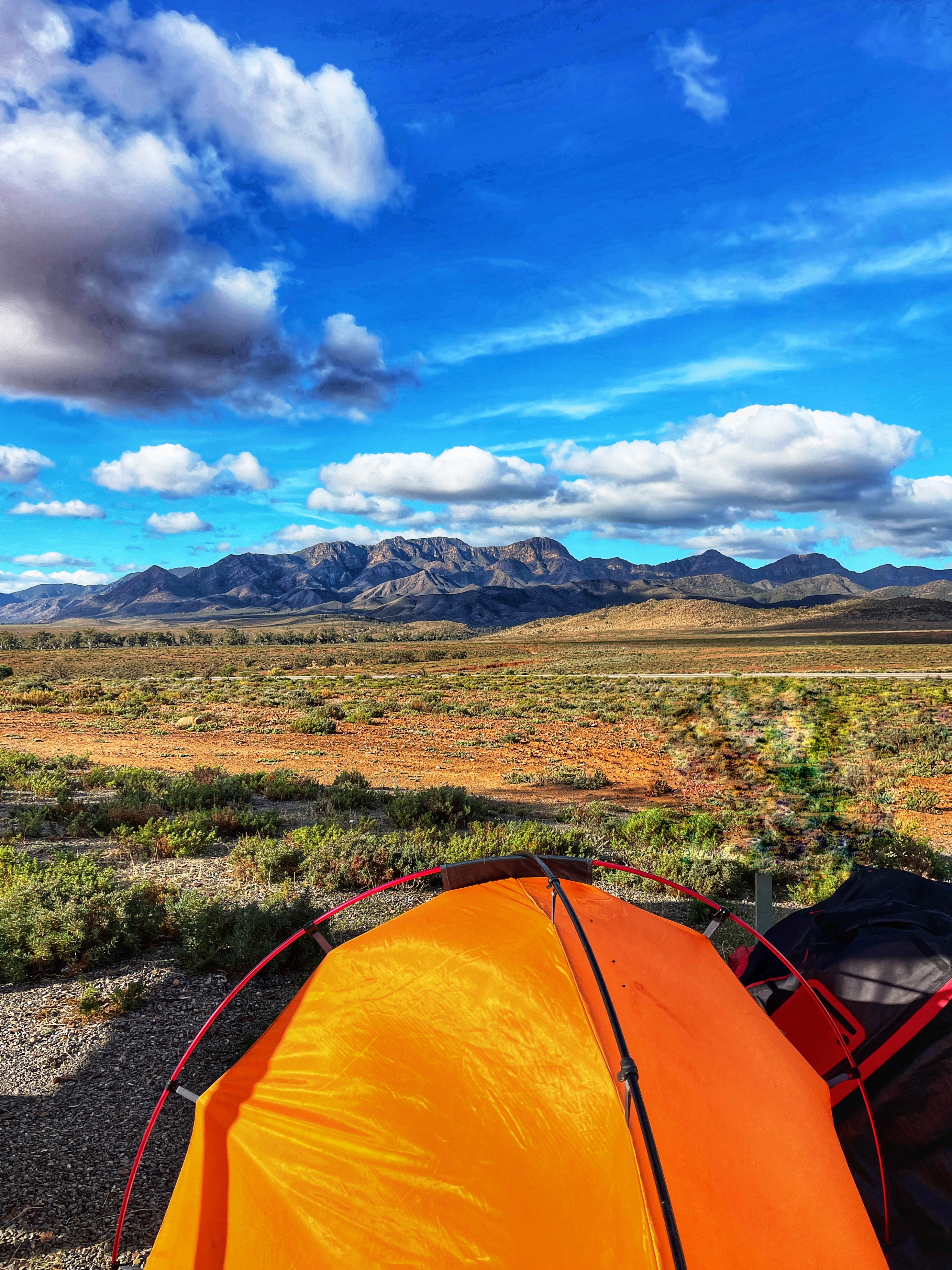
Share this article
